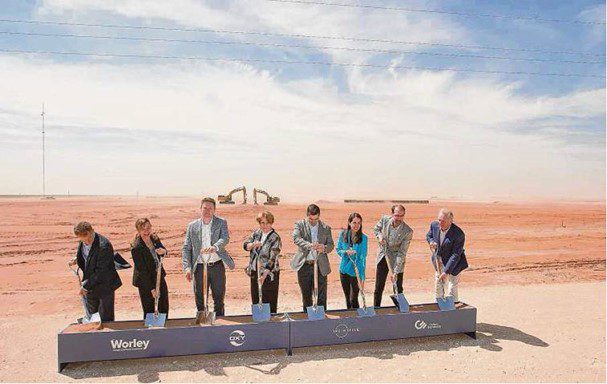Occidental Petroleum’s carbon capture project in West Texas is unveiled
By Amanda Drane STAFF WRITER
Photos by Elizabeth Conley/Staff photographer



ECTOR COUNTY — Occidental Petroleum’s energy transition strategy came into sharper focus Friday as it kicked off construction of its first direct-air carbon capture hub in West Texas.
The Houston oil giant, which is endeavoring to transform itself into a carbon management company, unveiled the Stratos facility here during a groundbreaking ceremony with corporate partners and investors.
Stratos, which could scale up to capture 1 million metric tons of carbon dioxide annually, is part of Oxy’s ambition to develop 100 direct-air capture facilities worldwide by 2035. The facility is scheduled to launch in 2025 with an initial capacity to capture 500,000 tons of carbon dioxide per year.
It’s the first of five such hubs Oxy is planning in industrial areas of Texas and Louisiana, where it aims to provide a solution to the problem of climate-warming pollution. It announced last month that it could trap as much as 1.2 billion metric tons of carbon dioxide at a 55,000-acre site that runs along the Texas Gulf Coast in Chambers, Liberty and Jefferson counties. It also plans to develop a massive carbon capture project on 100,000 acres south of Corpus Christi.
“It’s an ambitious challenge,” Oxy CEO Vicki Hollub said during the ceremony, “but one that is well suited to our skills and enables us to make a difference in reducing emissions.”
Oxy’s chemical business already markets large amounts of potassium hydroxide, a chemical key to the company’s direct-air capture projects in Texas, Hollub said. As for carbon management, it already stores as much as 20 million tons a year underground.
“In fact, Oxy is the largest handler of CO2 in the world,” said Richard Jackson, Oxy’s president of U.S. onshore resources and carbon management.
The Permian project was originally scheduled to begin construction last year and launch in 2024 but was delayed by supply chain challenges, the company said. It is expected to employ more than 1,000 people during construction and around 75 people after startup.
Oxy aims to forge a new path in carbon management, providing the service of capturing and storing carbon dioxide from industrial emissions or directly from the atmosphere and pumping it underground into geological formations.
The science, which is untested at the scale proposed by Oxy and other oil companies, may enable large parts of the region’s petroleum industries to stay viable in a low-carbon environment and could play an important role in the region’s emerging hydrogen economy. Carbon emitted during the process of making cleaner-burning hydrogen from natural gas would need to be captured to qualify a facility for federal tax credits.
Among big oil companies, Oxy has taken one of the more aggressive approaches to the energy transition, heading down a path that would reposition it as a carbon management company even as it continues to produce oil.
Hollub has touted her company’s carbon capture strategy as a key path for the transition. Using captured carbon for enhanced oil recovery yields net-zero barrels of oil, she has said, as it redeploys the carbon dioxide generated from burning oil for the purposes of extracting more.
“In my view, the world cannot afford the climate transition without doing it this way,” she told CERA-Week attendees last month.
Amanda.drane@houstonchronicle.com
